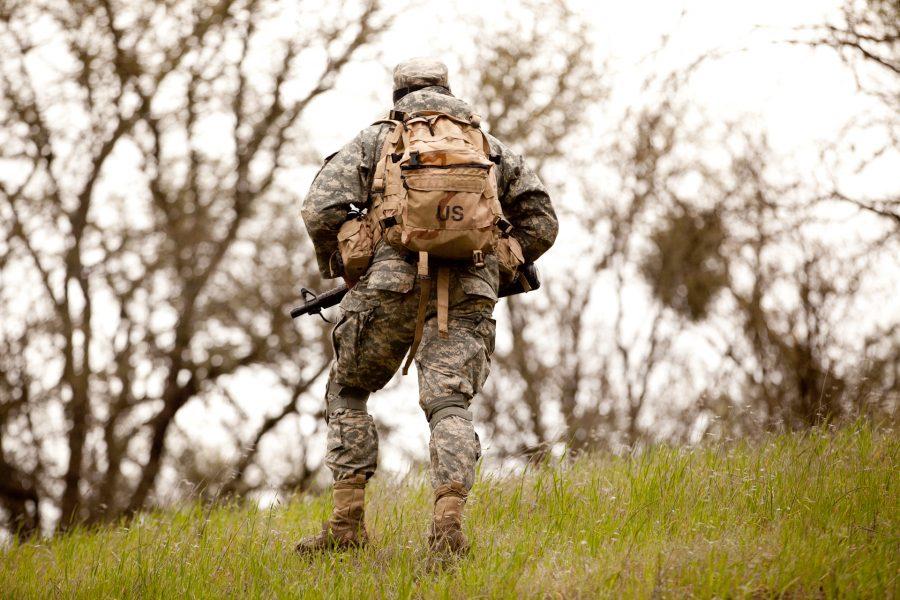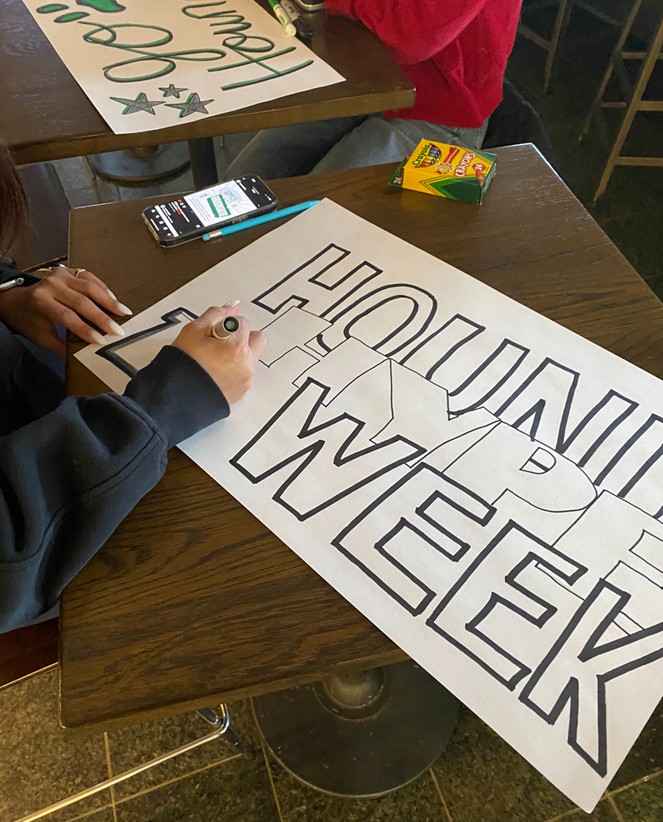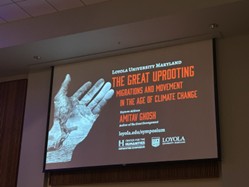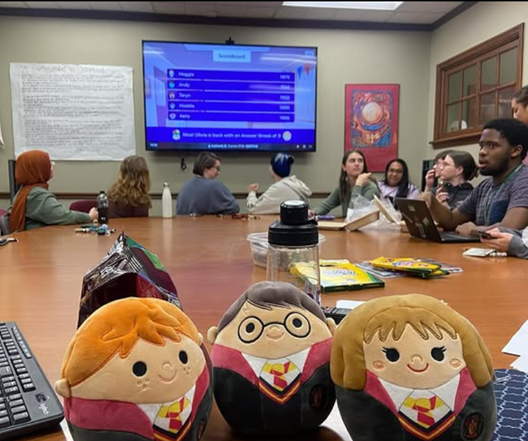While the crisp morning air blew past the sleepy dorm rooms of Loyola’s campus, the strong and determined footsteps of the Greyhound Battalion could be heard marching forward. Although a 05:00 AM roll out is a common sight for an Army ROTC cadet, April 2nd was a little different. On this cool and rainy morning, 94 cadets from four different schools (Loyola University, Towson University, Goucher College, and Notre Dame of Maryland University) were scheduled for platoon-level operations at Lauderick Creek in Edgewood, Maryland. I was given the privileged opportunity to join them for the day’s training, gaining an inside look at the Army Reserve Officers’ Training Corps in action.
After a quick thirty-minute drive to the Army training site, I stood in a parking lot with several upperclassmen cadets (the Battalion Staff) who were preparing for the day’s plans before the platoons arrived. They counted out replica assault rifles, “rubber ducks,” and laid them out neatly for the cadets to pick up later. Other supplies including compasses, maps, and three backpack radios were also set on the ground for the cadets to soon retrieve. The training site consisted of a few simple barracks and a vast expanse of wooded terrain where military operations and tactics could be learned and perfected. With the rain beating steadily, we were eager to get to the woods where the trees would provide some warmth and protection from the weather.
Upon my arrival, I was briefed on the mission for the day: Three platoons, each consisting of 20 to 30 cadets, would attack to destroy three separate objectives which were mapped out somewhere in the expansive woods surrounding us. The targets consisted of a few “bad guys” – upperclassmen cadets who played the role of an opposing force. The cadets were briefed on the mission in advance and were told to prepare a plan of attack. A platoon leader was selected beforehand as well, and as I would soon find out, the weight of the operation rested mostly in his hands.
Shortly after gaining an introduction to Army ROTC, the busses pulled into the parking lot and about 75 cadets, dressed in army combat uniforms, marched into order by platoon. There were three platoons that consisted of mainly first, second, and third year students. Each platoon was given some time to organize themselves and prepare for the mission ahead. My first lesson from a day with the Greyhound Battalion was that planning is key.
As the first platoon departed on their mission, they were abruptly halted by one of the cadre members (an experienced active duty officer that’s assigned to the Battalion as a military science instructor). The cadre did not want the cadets to walk down the middle of the road. Instead, they were supposed to get into the prone position to provide proper security while the rest of the Platoon cautiously moved across the road toward their target. As I quickly realized, the rain would not stop the cadets from getting into the elements; in fact, the majority of a young cadet’s day was spent crouching or lying down on the wet ground.
“Oh, it’s hard at first of course,” said one of the freshman cadets after being asked about the difficulty. Although rarely will you hear a cadet talk about this, because difficulty is expected. Without it, Army ROTC would not fulfill its purpose of producing strong and adaptive leaders who can face challenges head on.
While the platoon crept slowly toward the tree line, I couldn’t help but wonder how we would find such a small target among the boundless wilderness that surrounded us. Our platoon leader, who was chosen based on his strong leadership attributes, had the task of planning each step of the mission. From the moment his cadets stepped foot off the bus to the moment they cleared their target, it was his job to command and lead every action.
Once we crossed a road and a large field that served as an entrance to the woods, the platoon leader directed everyone past the tree line and into the forest. If the mission were real, the soldiers would not want to be visible from the road. The platoon leader regularly stopped the cadets to assess his map and plan the next steps. Each time he stopped, the entire platoon formed a security perimeter where they lay in the prone position and watch for enemy threats. The mission crept onward slowly, and I quickly learned that the role of platoon leader was a stressful and mentally demanding one. With both an experienced Cadre member and a senior cadet watching and critiquing your every move, the overall stress of a real battlefield is slightly replicated.
“Do I make you nervous?” sarcastically asked the Cadre, staring down at the young platoon leader. We all knew the answer to his question.
The platoon leader constantly referred to his map and compass to determine the timing of his next steps. When a decision was reached, squad leaders (in charge of usually eight cadets within the platoon) were called to the center of security for briefing. After speaking with the platoon leader, it was then the squad leader’s job to brief his or her fire team leader (in charge of usually three cadets within the squad) – thus spreading word throughout the platoon’s entire chain of command. This type of military hierarchy offers efficiency and control on the battlefield but takes time to perfect. If each leader does not fulfill his or her duty, the platoon will scatter or slow down, adding to the overall difficulty and danger of the mission.
As the platoon trekked onward, they crept furtively like a snake slithering toward its prey in the distance. The platoon leader, constantly referring to his map for guidance, decided after a long distance that the objective must be nearby. He stopped his cadets with silent hand signals that effectively maintained the stealth of the operation. Once the squad leaders all met the platoon leader in the center of security, it was time to form a leader’s recon element that would scout the territory ahead for signs of the enemy. I joined the scouting mission, and after a reasonable distance, they found the target which was further away than expected (about a fifteen-minute walk). Using the terrain features that surrounded them, including a large river in the distance, the cadets constantly looked back and forth between the land, a map, and a compass to find their objective.
The scouting operations were meticulous and time-consuming; the closer the cadets got to the enemy, the more cautious they had to be. Still, a great amount of information was gained from the reconnaissance, including the size (three personnel), activity, weaponry, and location of the enemy.
Once we returned from the leader’s recon mission, the platoon leader was swapped out and a new cadet was chosen to replace him. The new platoon leader would be responsible for the attack on the target, and this involved serious and accurate planning. The map was used throughout the entire mission, but here it was essential.
“Think about the next step. You always wanna be two steps ahead of what you’re doing right now,” said the Cadre to the platoon leader.
After each leader felt comfortable on the plan ahead, the entire platoon embarked on its attack. “Now’s the fun part,” said one cadet as we trekked further through the woods toward the enemy.
The objective, which consisted of a dense patch of brush and wooded vegetation at the end of a trail, became visible about fifty meters ahead, and the cadets hurried into position. One squad set up a support-by-fire position while another maneuvered around the left flank, forming a tactical “L” formation. Their onslaught began.
Since the cadets were using mock rifles, they yelled “BANG BANG” as a way to reenact actual gunfire. I watched and listened closely as the battle played out in front of me. The three enemies verbally fired back at the cadets and relied heavily on trees for cover. Once the barrage of yelling halted and the soft sounds of nature became recognizable, I watched as a slew of cadets stormed across enemy territory and captured their objective. All three “enemies” were lying on the ground either injured or dead.
The “injured” were carefully searched and their weapons were collected. Since it was already approaching 1500, which was our scheduled time of departure, the cadets cleared the enemy site and quickly marched toward the busses. Once we got to the parking lot, the three platoons arranged themselves in order and stood at attention facing their Lieutenant Colonel, a professor of military science. He recognized the latest members of the Battalion’s Ranger Challenge team (a competitive team within the Battalion that requires tryouts and extensive training) before the cadets were finally briefed for their departure back to Loyola.
On the ride back to campus, I thought about the friendships I’d witnessed along with the entire bonding experience of the day. I could not help but notice the great relationships that are created as a member of Army ROTC. There is undoubtedly a certain kindness and respect that is shared among the entire group, a group that holds a bond strong enough to consider itself “family.”
The mission to Lauderick Creek provided the cadets with tactical experience, but I certainly experienced far more than just this. Patience, focus, attention, respect, communication, and the ability to lead were just a few of the many characteristics I found myself evaluating throughout the day. I can only imagine the higher sense of inner fulfillment that must have been achieved as an active member of the operation.
As one cadet stated, it’s more than just training to be a soldier, “it’s how you carry yourself.” The missions and training for Army ROTC provide lessons that extend far beyond the battlefield. I, myself, stepping away from the military van and back onto campus, felt a sense of accomplishment and confidence from my day’s experiences with the Greyhound Battalion. And as the camouflaged cadets later strolled past me, chests out and heads high, I could tell they embodied the same feeling.
Image from Flickr Creative Commons: Karim Iliya
















































































































